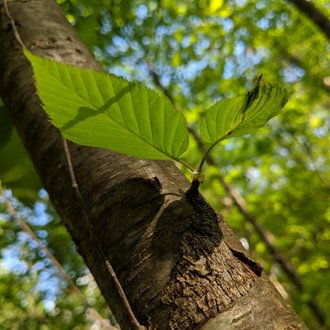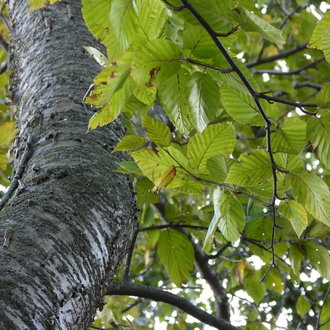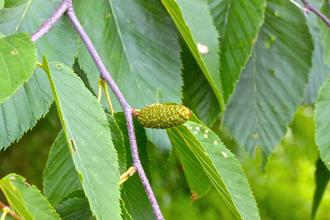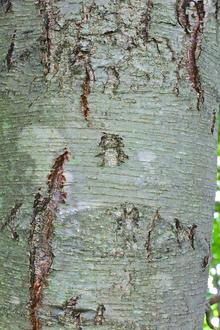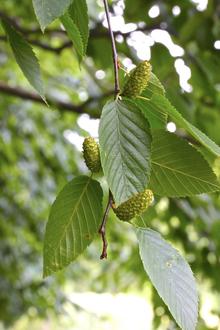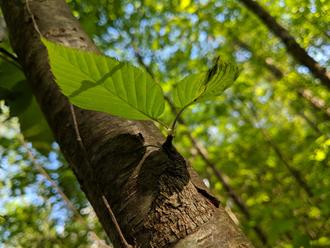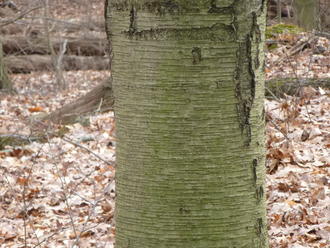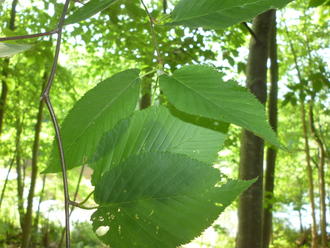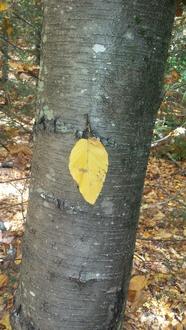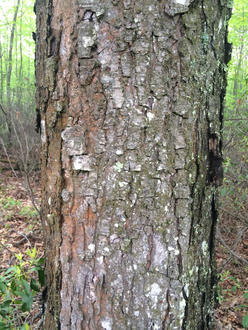Sweet Birch (Betula lenta L.)
Also known as black birch.
↑Summary
A tree native to eastern North America, mostly from the Appalachians through southern New England.
↑Similar Plants
↑Habitat
Found in forests, typically on moist, protected north- or east-facing slopes. Found mostly on the soil orders spodosols, inceptisols, and ultisols. Grows best on moist, well-drained soils, but sometimes found on coarse-textured rocky soils or thin soils over bedrock if sufficient moisture is present. Extends to sea level along the New England coast, but limited to higher elevations in the southern Appalachians.
Usually found in habitats where fire does not occur or is very rare.
↑Life Cycle
Sweet birch is a fast-growing medium-to-large tree that is sometimes characterized as a pioneer species, especially relative to other trees that occur together with it on cool, moist slopes. It often establishes in gaps or following disturbances on these sites, where it temporarily out-competes more shade-tolerant species such as hemlock, beech, sugar maple, and even red maple and yellow birch, with its rapid growth.
Seed production begins when trees reach about 40 years of age and increases until it begins to decline around 100 years of age. Trees sometimes produce good seed crops two years in a row, but other times skip a year.
Seeds mature in early fall, and are released from mid-September into November, and are dispersed primarily by wind, with crusted snow aiding in the long-distance dispersal of some later-falling seeds. Little is known about quantity or seed production or typical dispersal distance.
Most seeds germinate the following spring, following a period of cold dormancy. Germination occurs on the soil surface, and is staggered over a period of 4-6 weeks. Seeds can germinate in exposed mineral soil, humus, and rotting longs. Survival is low, and is best when trees are shaded from the side, or shaded lightly above, especially during their first summer. Under a somewhat open canopy, such as that of white pine, sweet birch can form a seedling bank. However, trees cannot persist under denser shade.
Sweet birch has some ability to resprout from the the stump when young, but it tends to be a less prolific resprouter than other associated trees including sugar and red maple, beech, yellow birch, and northern red oak.
Clearcutting can favor sweet birch, but only if a seedling bank exists and is preserved during logging, as new seedlings do not establish well in open conditions.
Trees over 100 years of age are common, and two individuals have been recorded reaching 192 and 265 years of age. Trees often die following ice storms, perhaps due directly to crown damage, or indirectly due to rot. In the absence of ice, however, this species is highly cold tolerant and often less damaged by severe cold than other trees in its habitat. Trees of any age are highly susceptible to fire, including ground fire, due to their thin bark. Even minor fires can indirectly kill trees by leaving them vulnerable to insect damage and rot.
↑Uses
Historically used to produce birch beer, together with Yellow Birch (Betula alleghaniensis). These two species, but not most other birches, contain significant amounts of methyl salicylate, a compound known for its distinct and pleasing wintergreen aroma. This is the preferred species of the two, as it has a higher methyl salicylate content.
Also used for wood; the physical properties are similar to yellow birch, but when exposed to air, the wood of this species darkens considerably, which has historically led this species to be used as a substitute for mahogany. As a wood, it is easy to work with but has poor resistance to rot and insect damage. Along with other birch, it is one of the more common woods used in veneer and plywood, and also used for boxes, crates, turned objects, interior trim, doors, furniture, or paneling.
This species is rarely used in landscaping, and is not widely available in nurseries. Its use in landscaping is limited by several factors, including poor tolerance of drought, compacted soils, or heavy shade, poor response to spring pruning, and being difficult to transplant. Once established, however, it grows rapidly and makes an attractive shade tree for moist sites, and it can tolerate a range of soil types, poor drainage, and exposure to road salt or salt spray from the ocean.
↑Related Plants
Closely related to yellow birch (Betula alleghaniensis), but not known to hybridize naturally. Artificial hybrids have had low vigor. This species may be closely related to the rare, endangered Virginia roundleaf birch (Betula uber), which was formerly classified as a variety of this species. Also closely related to bog birch (Betula pumila), with which a natural hybrid has been recorded.
↑Links & External Resources
• Sweet Birch | The Wood Database (About This Site)
• Betula lenta (Sweet Birch) | USDA PLANTS Database (About This Site)
• Betula lenta | Go Botany (About This Site)
• Sweet Birch | iNaturalist (About This Site)
• Sweet Birch | Virginia Tech Dendrology Factsheets (About This Site)
• Sweet Birch | Silvics of North America (About This Site)
• Betula lenta | Biota of North America Project (BONAP) (About This Site)
• Betula lenta | NatureServe Explorer (About This Site)
• Betula lenta | Flora of North America (About This Site)
• Sweet Birch | Maryland Biodiversity Project (About This Site)
• Betula lenta L. var. lenta (Sweet Birch, Black Birch) | Digital Atlas of the Virginia Flora (About This Site)
• Betula lenta L. var. uber Ashe (Virginia Roundleaf Birch) | Digital Atlas of the Virginia Flora (About This Site)



